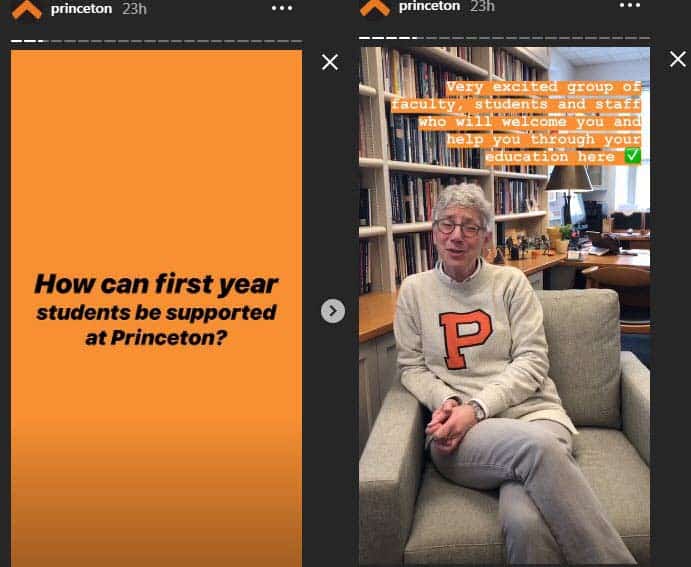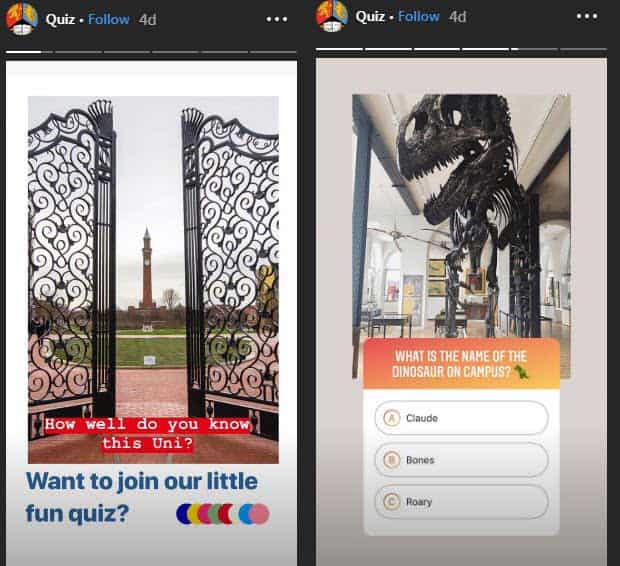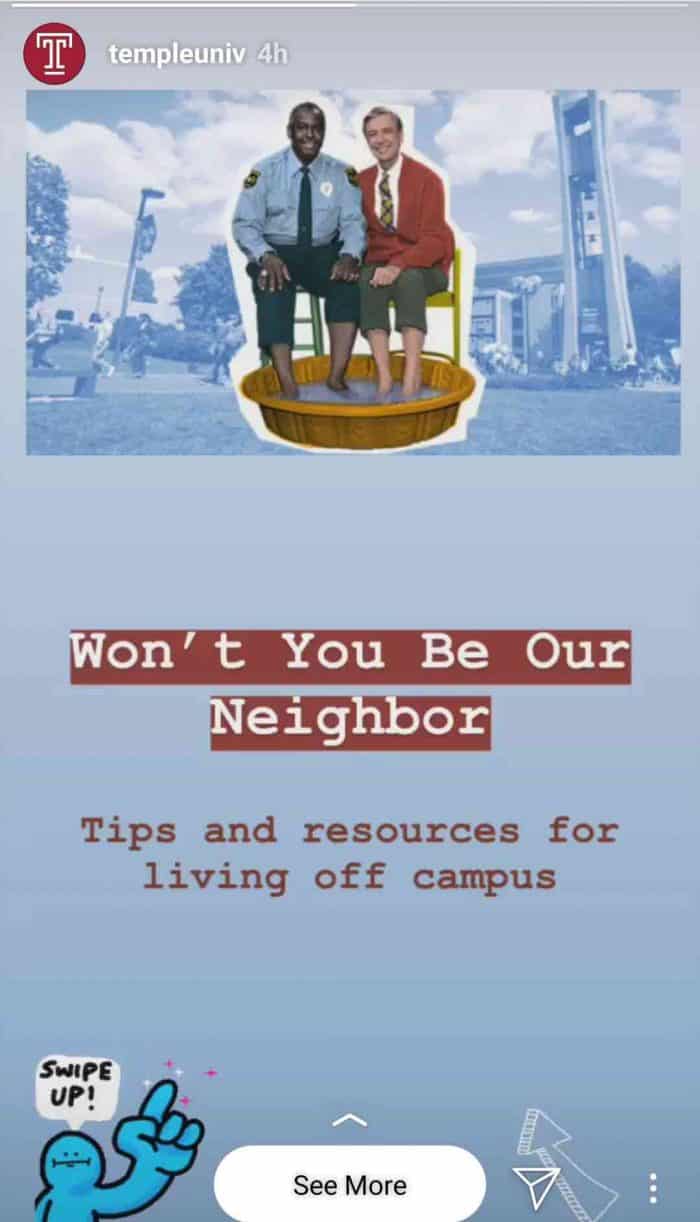
At this point, you’ve probably come across your fair share of stories on social media channels like Facebook, Instagram and Snapchat. But how many good ones have you seen?
Like many other types of digital content, the material produced in the early days of stories has often been a bit slapdash, as creators experiment with different approaches in an attempt to get to grips with the new format.
As more and more stories are published, however, people are getting a much better sense of what is working and what isn’t, and social networks are also offering more guidance to help users.
Recently, for instance, Facebook published a new study which goes some way to offering some general best practices for stories ads creation, many of which can also be applied to organic posts. Other experts have also been weighing more on what brands can do to make their stories more engaging. Keep reading to learn what your school can take from these findings.

1. Turn the Volume Up on Your Higher Ed Social Media Stories
One key takeaway from the Facebook study is also one of the simplest. The company advised that ads which included sound performed 80% better than those that didn’t in terms of driving lower funnel results. This means that your school is likely to see more success if you include an audio element in your stories.
Because stories ads are played within the stories feed, this tip can arguably be taken to apply equally to both advertising and organic posts, as the findings imply that the average stories watcher is engaging with them using audio. Your school can add sound to both by using the audio in any video footage you are taking, or experiment with adding music or even a simple voiceover to your clips.
Of course, it is still worth remembering that some users will have the sound off. If audio is really important to your story, you might consider adding a sticker to it to prompt users to turn the volume up.
Example: The University of Pennsylvania added a sticker and a text overlay to this post to let users know to turn on the sound to get its full effect.

2. Set a Fast Pace with Your School’s Posts
Another interesting revelation from Facebook’s study was that users actually consume stories content faster than any other mobile format. This has led the social media giant to conclude that brands should ‘leverage speed as a creative element’ to hold viewers’ attention. As an example, they offer a Ritz ad which rapidly flashes a number of different recipes in a single frame:

The key takeaway for schools here is that it’s best to keep your higher education social media stories content moving. Each frame of your story is visible for 5 seconds if it’s an image, and up to a maximum of 15 if it’s a video. While this may seem like a short interval, it can feel like an age if there is nothing happening on screen. By keeping your content busy and moving, you can keep students engaged.
Example: The University of Chicago created this story about its recent Giving Day event. Where other creators might have used an ordinary image at the centre of the frame, the school opted for hyperlapse footage which moved through the campus and captured the action. The result – which you can view in full here – makes for a much busier piece of content with a far more vital feel.

3. Divide Your Stories Content into Scenes
The easiest way to keep your story moving is to break it up into short scenes. Rather than using the maximum video clip length for each slide of the story, your school could chop your content up into more succinct clips.
This can make it easier to hold a viewer’s attention, and if done well, will also create more of a narrative for your story. Your school can use different kinds of filters, stickers, and camera angles to differentiate your clips from one another and make each ‘scene’ feel fresh and new.
Example: Columbia University does a good job of splitting its stories into contrasting scenes.

4. Use a Mix of Video and Still Images in Your School’s Stories
While keeping your content busy is important, you need to be careful not too have too much of a good thing. A story which moves a mile a minute might disorient viewers, and make it harder for them to take in its message.
One way of providing some contrast in your story is to use a mix of still images and videos. Facebook states that there is a 75% chance of stories ad campaigns which use mixed formats performing better, and recommended incorporating both into ad sets.
This can hold true in organic stories too, where your school can use images to break up video footage and help underline the narrative of your post. This type of structure can lend itself particularly well to things like Q&A sessions with current students or faculty members.
Example: Princeton University put together this Q&A for incoming students with Dean of the College Jill Dolan. The story uses still images to frame questions, before cutting to videos of Dolan answering. Note how the school uses text overlays in the video footage to underscore important points.

5. Use Stickers that Invite Engagement from Prospective Students
There is a myriad of different, fun, and interesting stickers available in stories on all platforms, and your school should find no shortage of creative ways to spice up your visuals with them. Perhaps the most effective, though, are the ones which directly drive interaction and engagement.
For instance, many schools use stickers to place questions to prospective and current students within their stories. This can be used for polls, quizzes, or just to seek general feedback.
Example: The University of Birmingham created a trivia quiz story on Instagram, in which users are posed questions about the school. It serves as a fun, interactive way to highlight what makes the institution unique.

Other stickers will actually prompt users to type messages directly to your account. This can be very effective for Q&A sessions, or just to drive general feedback about your school, courses, or location.
Example: Centre of English Studies makes great use of question stickers. The language school posted this ‘General Info’ story in its Instagram ‘Highlights’ section – which means it permanently appears on the school’s profile page, and can be added to over time. In the story, users are invited to type in any questions they have, and the school then adds the answers to its story.

6. Don’t Overuse Stickers in Your Posts
While stickers can be a great way to make your visuals unique, it’s important not to overuse them. Facebook found that the use of stickers saw mixed results in ad campaigns. Video story ads delivered 83% better results with stickers, but static image story ads actually had an 87% better chance of converting if they didn’t use stickers. The company’s own inference of these results is that, when used well, stickers can help to engage your audience, but that adding them unnecessarily can create problems.
With that in mind, the best solution is perhaps to think carefully about whether a sticker will really add something to your story before including it. You should also look at the total amount of stickers in your overall post and how frequent they appear, and ask yourself if you are overdoing it.
7. Place Text Carefully in Higher Ed Social Media Stories
Another element of stories which you should be mindful not to lean too heavily on is text. While text overlays are a crucial component of the format, and help to communicate your narrative more clearly, stories are still intended to be a predominantly visual medium.
As such, your school needs to be careful not to overemphasize text in your slides, or to use too much of it. Spreading it over a number of different slides might be a good way to fit all the information you need to while still keeping your stories visually engaging.
Example: This story from the Wharton School spread its text overlays over a number of slides.

8. Create ‘Tap to Reveal’ Posts for Prospective Students
If you want to get really creative with stories, one interesting option is to create a ‘tap to reveal game’, in which the story gradually reveals an image frame by frame. You can do this by adding a layer of colour over the image, then gradually erasing parts of the top layer, and saving each version of the image as a frame in your story.
Example: Duke University created this sophisticated tap to reveal story to announce its commencement speaker (Duke graduate and Time’s Up CEO Lisa Borders), gradually revealing pieces of the puzzle while offering clues about her identity.

This is a simple but very innovative use of the stories format, and could be a great option if you have exciting news to share, such as the unveiling of a new course, building, or other facility on your campus, to announce events, or even to introduce new staff members.
9. Keep Your Stories Consistent with Your School’s Brand
Additionally, while stories offer a smorgasbord of readymade designs, graphics, and filters, it can be beneficial to try and maintain some level of consistency with your school’s overall branding and design elements.
Example: The University of Michigan does a great job of using its school colours consistently across its marketing initiatives, including stories.

Using your institution’s colours, logos, and other assets will help prospects instantly associate content with your school, and reinforce your brand identity.
10. Use Stories CTAs to Drive Inquiries from Prospects
One of the most important elements of social media stories for schools is CTAs. The CTAs in stories provide an incredibly effective way to drive traffic to your website, videos, social media accounts, and landing pages. Despite this, many schools will fail to add CTAs to their stories, which can dramatically reduce the impact the format can have in your student recruitment efforts.
It’s also important to draw as much attention to them as possible. Facebook advise that there is an 89% chance that stories ads which strategically emphasize their CTA will drive conversions more effectively than those that don’t. This can be as simple as adding a text overlay to your final slide advising prospects to swipe up. It’s a small detail, but one that can make a huge difference to your overall results.
Example: Temple University added a cartoon character to draw more attention to the CTA in this story post.

11. Have a Clear Objective for Your School’s Social Media Stories
Perhaps above all else, the effectiveness of your higher ed social media stories will come down to how clearly you have thought about your objective.
Whether you are running ad campaigns or just posting in your feed, it’s important to have a clear picture of what you hope to gain from investing in the format, whether it’s attracting more inquiries, raising awareness of your brand, or just engaging your existing online community more effectively.
From there, you can begin working to produce content that helps you move towards that goal, and start seeing the benefits of this dynamic and exciting new medium.






